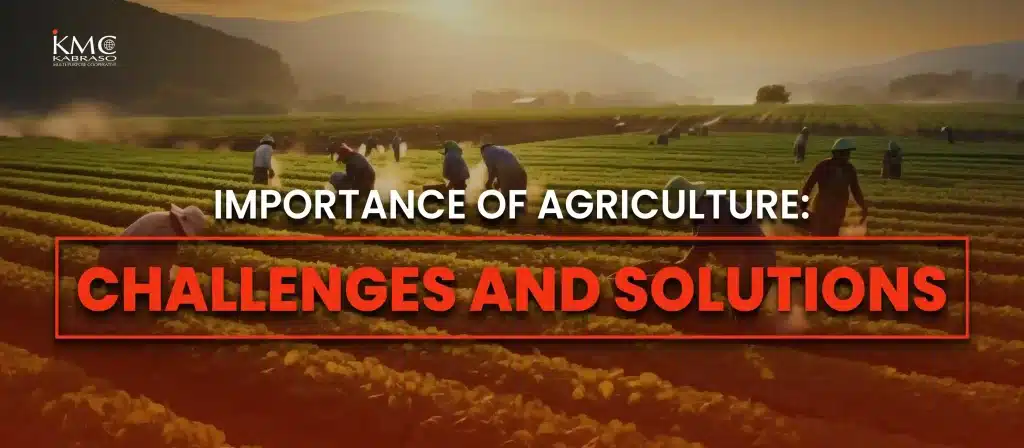Table of Contents
Identifying the challenges in the agriculture sector helps economic leaders and local farmers in mitigating potential risks to business and resolving typical agricultural problems. This blog explores the agriculture industry, highlighting its economic benefits, recurring challenges, and the country’s resilience in overcoming them.

What is agriculture as an industry?
The agriculture industry involves crop cultivation and livestock raising from local farmers who grow organic fruits and vegetables, to large-scale producers of livestock, grains, and other essential goods for consumption. It is mainly divided into four sub-sectors that collectively support food security and economic sustainability.
The 4 sub-sectors of the Agriculture Industry

Crops
In the Philippines, the dedicated land area for crop cultivation is around 13 million hectares. Filipino farmers protect their farmland against pests and diseases to ensure they deliver high-quality produce to the consumers in the country.

Fisheries
The fisheries sector accounted for 46% of aquaculture production in the first quarter of 2024. It provides employment and a source of income to fishermen, supports economic exportation, and satisfies the dietary protein needs of the majority of the population.

Forestry
Forestry supports most of the population, including indigenous people in rural areas. Many parts of the world, including the Philippines, have already established forest farming systems. This promotes ‘food forest’ which is the type of food production system that focuses on perennial plants and trees like fruits, nuts, and vegetables.

Livestock
Livestock has an essential role in Filipino cuisine, driving a significant increase in market demand. Recent studies show a 30% rise in livestock’s contribution to the agriculture sector’s Gross Domestic Product (GDP) in the Philippines. From breeding to processing and market distribution, each step in the livestock supports agriculture’s overall growth.

How does agriculture help the economy of the Philippines?
Over 50 million Filipinos who live in rural areas rely heavily on agriculture for their food resource and livelihood. With the Philippines’ rich agricultural resources, Filipino farmers are able to export products to countries like the United States, Japan, and the Netherlands.
The categories of agricultural exports include food and live animals, tobacco products, animal and vegetable oils, processed fertilizers, and agricultural machinery.
Labor record in agriculture
In early 2022, around 25% of Filipinos worked in four sub-sectors of agriculture. Among these industry groups is livestock, which contributes the highest number of laborers. In the same year, the unemployment rate dropped to 2.6% from the previous record of 3.4%. This shows a sign of recovery from the highest employment rate of 4.05%.
Although agriculture contributes almost 9% to the country’s GDP. There are still challenges in its sub-sectors that keep it from being sustainable.

Problems in agriculture in the Philippines
COVID-19 pandemic spread a virus that harms agricultural production. African Swine Fever (ASF) badly affected hog-raising farmers. The Ukraine-Russia war disrupted oil and food security. Natural disasters, made worse by climate change, also harmed farmers and fisherfolk.
As a result, the food inflation in the Philippines increased from 10.6% in 2022 to 11.2% in 2023. The local supply drop, which failed to meet high demand, was mainly because of the policy challenges during the pandemic. These measures disrupted food production, sustainable agriculture, and supply chains, limiting the availability of goods and resources in the market.
Rising cost of essential goods
The rising cost of essential goods always starts from agricultural production. Apart from the consumers, farmers are on the frontline when it comes to inflation. After all, agricultural production is the backbone of a profitable agribusiness in both the public and private sectors.
With all things considered, here are the following challenges faced by the agricultural sector in the Philippines.

Among the many issues confronting the agriculture sector are fluctuating markets and climate change. More recently, inflation has become an increasing concern. Rising costs of agricultural materials like feed, gasoline, and fertilizers have severely reduced farmers’ profits.

Small-scale farmers lack the financial resources needed to cover essential materials like fertilizers, pesticides, and other expenditures. They also have limited access to well-developed agricultural machinery and equipment resulting in poor quality produce. As a result, they turned to moneylenders who demanded monthly interest rates that harmed their profit.

Water irrigation can improve productivity and increase the income of farmers. However, they still face challenges in this aspect that create serious problems. Hence maintaining proper irrigation can be challenging in a tropical country, especially during flash floods or droughts.

Using modern equipment boosts the productivity of farmers in agriculture and fisheries. However, most farmers cannot afford advanced tools because of limited financial resources. This hinders their adaptation to improve farming and fishery practices.

Farmers struggle to get their produce to local markets because of unstable road conditions and logistical challenges. They can also use a bicycle to transport their produce from the farm to the nearby market. However, this can be difficult and time-consuming, especially with the country’s weather conditions. They often have to sell their produce at low prices because they can’t move it to places where demand is higher.

Addressing the problems in the agriculture sector
Implementing strategic solutions is the key factor in overcoming the challenges that harm the agricultural sector in the Philippines. It is better to mitigate potential risks firsthand in sustaining the agriculture business management and improving farming productivity.
Local governments can provide support and subsidies for essential agricultural supplies to lower costs for small-scale farmers. There are low-interest loans available to help farmers boost profits and lessen inflation’s impact on their livelihoods.
By forming cooperatives, farmers can access a wide pool of resources that will help them leverage production costs. This can help farmers leverage their income by having the power to diversify their crop production.
Developing sustainable infrastructures like solar-powered or drip and sprinkle-centered irrigation systems can mitigate water shortages for agricultural crops. This strategy requires consistent maintenance to ensure the systems remain functional during severe weather conditions. Rainwater collection systems are another useful practice that provides a backup water supply during the dry season.
The Department of Agriculture (DA) supports qualified farmers by making advanced agricultural machinery and equipment more accessible through its facility support services program. With proper training and the ability to adapt to new agricultural technologies, farmers can improve their productivity.
Fixing rough roads in rural areas can improve the quality of agricultural goods delivered to local markets. Not only will it reduce the spoilage of the products, but it will also ensure that farmers can sell their crops at compelling prices.
Partnering with logistics to streamline the distribution process of agricultural products reduces the transportation costs for farmers. Furthermore, maximizing cold storage facilities can prolong the shelf life of agricultural products.
Conclusion
Addressing the problems in the agriculture sector includes a flexible approach that focuses on modern practices, climate change prevention, financial support, and developing infrastructures. It’s important to work together to create a more sustainable and profitable agribusiness. This collaboration will help farmers and ensure stable food supplies and prices for consumers.
Ready to transform your business?
Here at Kabraso, we ensure that your business overcomes labor challenges in the agriculture sector. We are dedicated service providers ready to help you reach success in the agricultural landscape.
Let’s Collaborate
